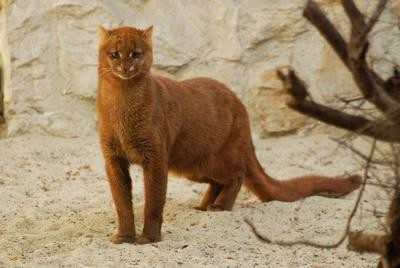
JAGUARUNDI (carnivorous)
Jaguarundi
The Jaguarundi is a wild cat native to the Americas. Its range extends from central Argentina in the south to northern Mexico, through Central and South America east of the Andes. The jaguarundi is a medium-sized cat of slender build. Its coloration is uniform with two color morphs, gray and red. It has an elongated body, with relatively short legs, a small, narrow head, small, round ears, a short snout, and a long tail, resembling mustelids in these respects. It is about twice as large as a domestic cat, reaching nearly 360 mm (14 in) at the shoulder, and weighs 3.5–7 kg (7.7–15.4 lb).
Phylogeny and evolution
The jaguarundi is most closely related to the cougar; the jaguarundi-cougar clade is sister to the cheetah. These three species comprise the Puma lineage, one of the eight lineages of Felidae; the Puma lineage diverged from the rest 6.7 million years ago. The sister group of the Puma lineage is a clade of smaller Old World cats that includes the genera Felis, Otocolobus and Prionailurus.
Characteristics
The jaguarundi is a medium-sized cat of slender build and uniform coloration that differs significantly from other neotropical cats - such as the small, spotted cats in the genus Leopardus - in its external appearance. This has been attributed to variations in its karyotype - the jaguarundi has 38 chromosomes, unlike the 36 in other small South American cats, and the chromosomal features resemble those of Old World cats such as the leopard cat (Prionailurus bengalensis). In fact, the jaguarundi shows several features seen in mustelids such as otters and weasels - it has an elongated body with relatively short legs, a small, narrow head, small, round ears, a short snout and a long tail. Males are slightly larger than females.
The coat is uniformly colored with at most a few faint markings on the face and the belly, though kittens are spotted for a short duration. Black and white marks on the lips and the snout, similar to those of the cougar, can be clearly seen in juveniles and some adults.
Distribution and habitat
The jaguarundi inhabits a wide variety of habitats, from tropical rainforests and deciduous forests to deserts and thorn scrubs. It can also be found in cloud forests, mangroves and savannas. Unlike the sympatric margay, ocelot and oncilla, the jaguarundi can live in open areas as well.
The range extends from central Argentina in the south to northern Mexico, through Central and South America east of the Andes - second only to the cougar in the latitudinal extent of its distribution.
Behavior and ecology
The jaguarundi is shy and reclusive, and apparently very cautious of traps. There have been only a few radio telemetry studies of jaguarundis in Belize, Brazil and Mexico. Though activity has been observed throughout the day and at night, jaguarundis seem to prefer hunting during daytime and evening hours; for instance, a study in Belize reported that jaguarundis started moving before dawn and remained active through most of the day till sunset with a peak in hunting from late morning to noon. The cat appears to be more diurnal than most other cats, especially spotted cats that tend to be more active at night. The jaguarundi can swim across medium-sized rivers; one in Bolivia was recorded swimming across the. Jaguarundis are efficient climbers as well, but hunt mainly on ground; the coat color works as a good camouflage for terrestrial activity